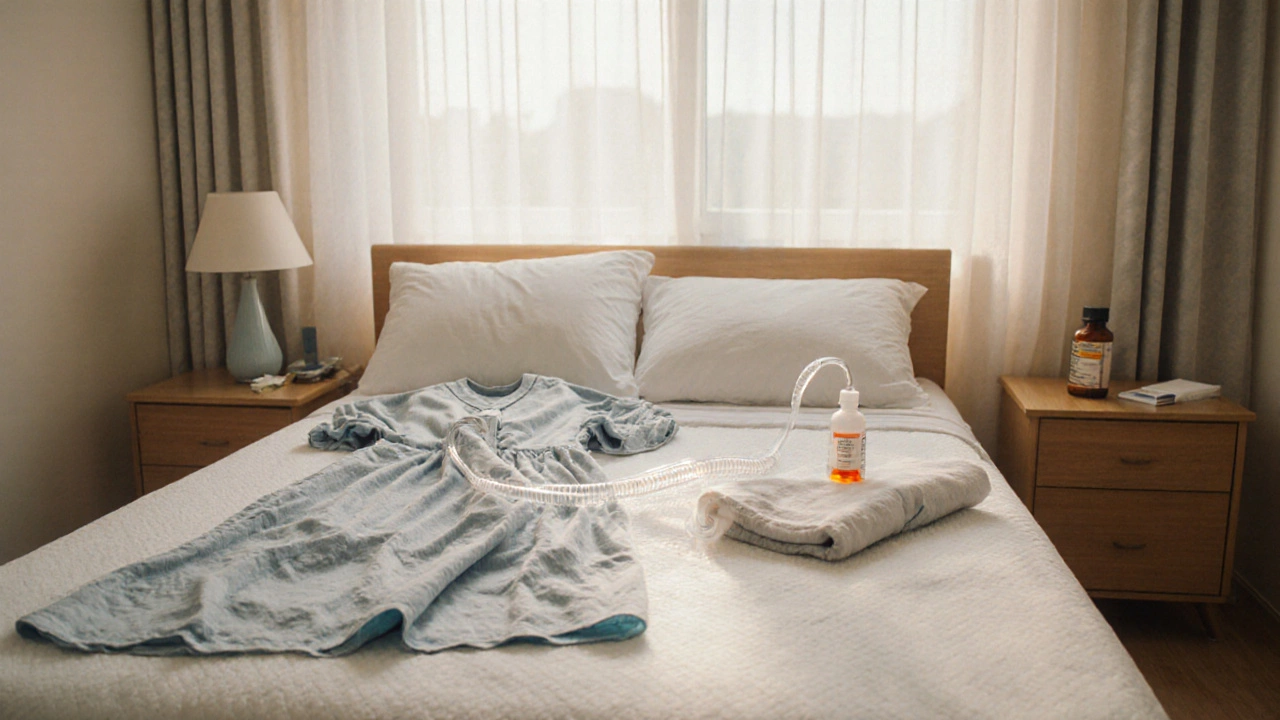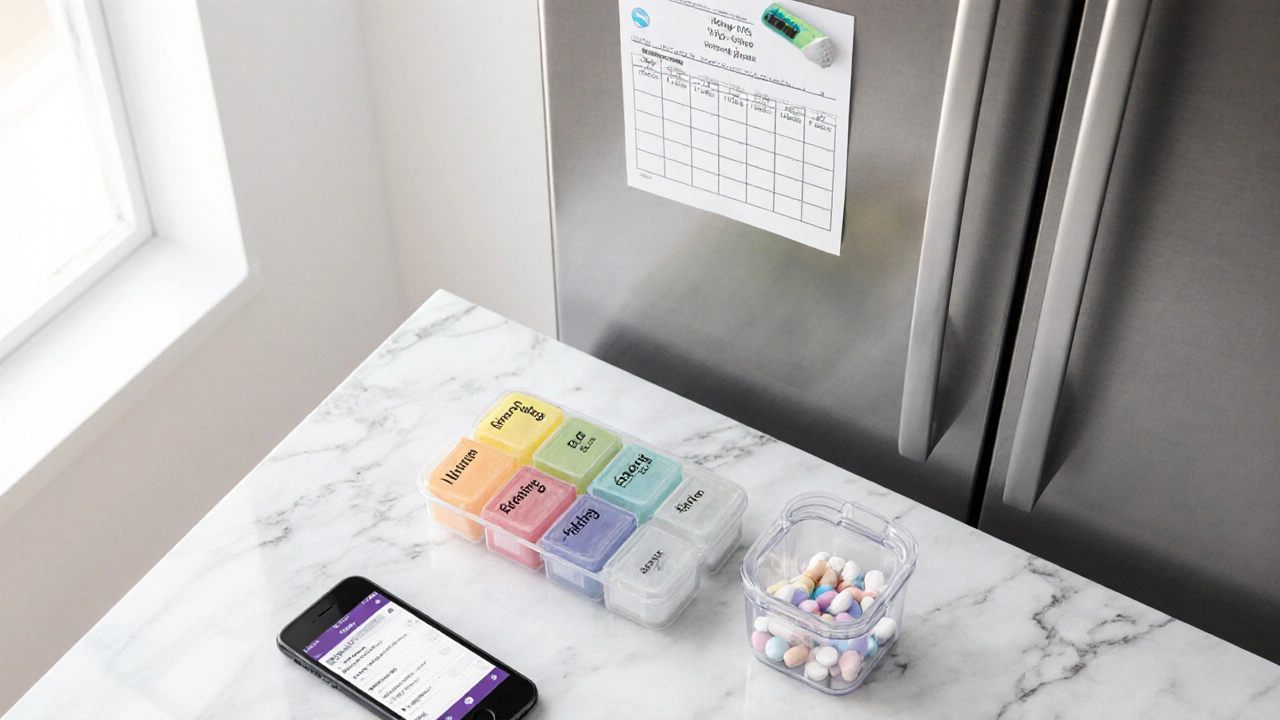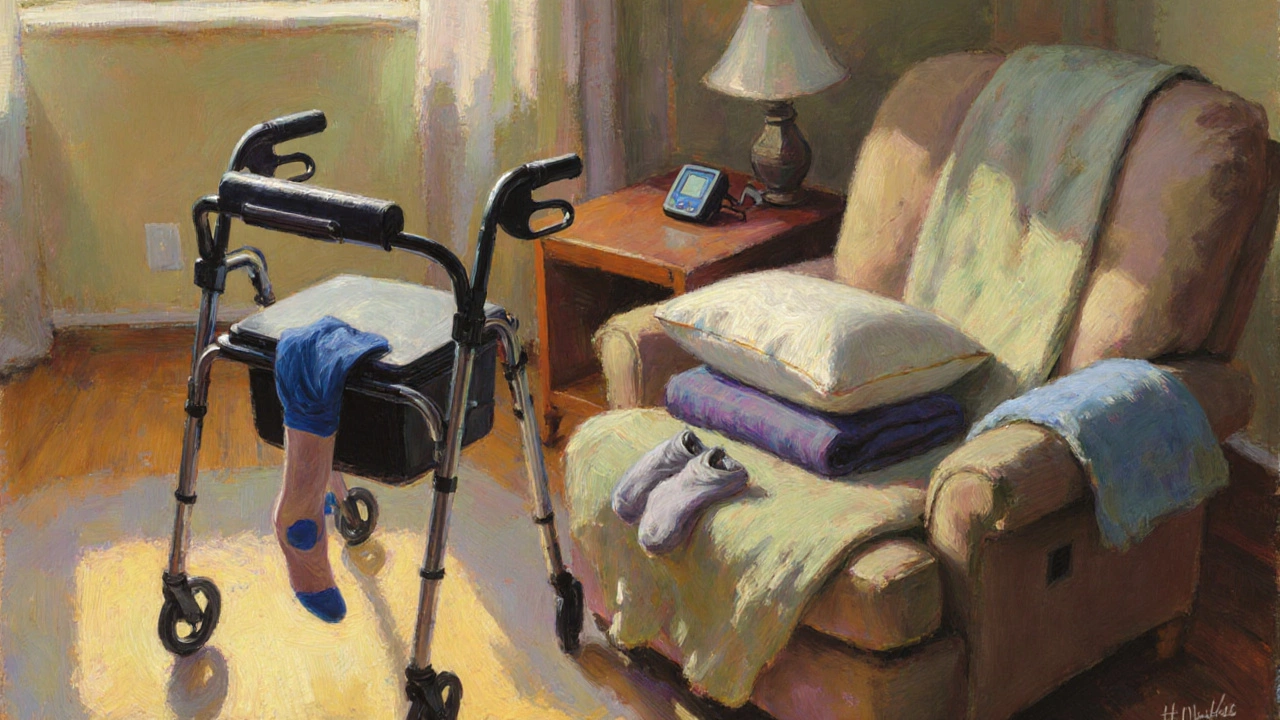
Post-Open Heart Surgery Recovery Tracker
Recovery Progress
Recovery Tip
Start with short, frequent walks around the house as soon as you're cleared, aiming for 5-10 minutes each session and gradually increasing duration.
Coming home after an Open heart surgery is a major milestone, but the real work begins when you step through the front door. Knowing exactly what to have on hand can make the difference between a smooth healing process and a stressful setback. Below is a practical, step‑by‑step guide that covers everything from medical gear to daily routines, so you can focus on getting stronger.
Immediate Post‑Surgery Essentials
Within the first 24‑48 hours, the priority is comfort, wound protection, and monitoring. Have these items ready before discharge:
- Prescription pain medication (usually an opioid and a non‑steroidal anti‑inflammatory)
- Light‑weight, loose‑fitting nightgowns that won’t rub the incision
- Disposable waterproof mattress protector to guard against any drainage spills
- Chest drain tubing and collection container (if still attached)
- Soft, breathable splint for the chest area to protect the incision when moving
Ask your surgeon for written instructions on how long each item is needed. Most chest drains are removed within 1‑3 days, but you’ll want supplies on standby just in case.
Medication Management Made Simple
Keeping track of pills can feel overwhelming, especially when you’re dealing with fatigue. Set up a dedicated medication station:
- Use a pill organizer with compartments for morning, afternoon, evening, and bedtime.
- Label each compartment with the drug name, dose, and any specific timing (e.g., “take with food”).
- Place a printed medication schedule on the fridge so you can glance at it while cooking.
- Store aspirin, clopidogrel, or other antiplatelet agents in a separate, clearly marked container to avoid mix‑ups.
Consider a medication reminder app on your phone, but keep a paper backup for days when the battery dies.
Incision & Wound Care
Proper wound care reduces infection risk and promotes faster healing. The following kit should be ready:
- Sterile gauze pads (size 4 × 4 in) for dressing changes
- Adhesive strips or surgical glue (as prescribed)
- Antibacterial ointment (e.g., bacitracin) for the first few days
- Disposal bag for used dressings
- Hand sanitizer or soap for thorough hand washing before each change
Change dressings according to your doctor's schedule-usually once a day after the first 48 hours. Look for signs of redness, swelling, or foul odor, and call your care team immediately if anything seems off.

Mobility Aids and Physical Support
Getting up and moving safely is crucial to prevent blood clots and improve circulation. Stock the following:
- Mobility aid - a sturdy walker or rolling walker with a seat.
- Non‑slip socks or slippers that fit snugly.
- Support pillow for the chest (a wedge pillow helps keep the upper body slightly elevated).
- Handrail for stairs or a portable stair‑rail kit if you have multiple levels.
- Compression stockings (usually prescribed for the first 2‑4 weeks) to aid leg circulation.
Start with short, frequent walks around the house as soon as you’re cleared, aiming for 5‑10 minutes each session and gradually increasing duration.
Heart‑Healthy Nutrition & Hydration
Food fuels recovery, and a heart‑friendly diet supports long‑term health. Build a grocery list around these principles:
- Plenty of fresh vegetables-especially leafy greens, broccoli, and carrots.
- Lean protein sources: skinless poultry, fish rich in omega‑3 (salmon, sardines), and plant‑based beans.
- Whole grains like oatmeal, brown rice, and quinoa to keep blood sugar stable.
- Low‑sodium broth, herbs, and lemon for flavor instead of salt.
- Hydration: aim for 8‑10 cups of water daily; add a slice of cucumber or mint for variety.
If your doctor recommended a specific sodium limit (often <1500 mg per day), keep a nutrition tracker handy for the first month.

Monitoring & Safety Devices
Self‑monitoring gives peace of mind and early warning of complications. Equip your home with:
- Blood pressure monitor - a digital arm cuff that stores readings.
- Pulse oximeter to check oxygen saturation, especially if you have sleep apnea.
- Thermometer for detecting fever.
- Emergency contact list pinned near the phone, including your surgeon, cardiologist, and nearest urgent care.
- Weighted blanket or extra pillows to help you stay comfortable while lying down.
Record your blood pressure twice daily (morning and evening) and share the log with your nurse during follow‑up calls.
Emotional & Social Support
Recovery isn’t just physical. Having a support network can lift your mood and improve outcomes. Consider these steps:
- Schedule short daily video calls with friends or family to stay connected.
- Invite a caregiver or loved one to help with meals and light chores for the first two weeks.
- Join an online forum for heart‑surgery patients-real‑world tips are priceless.
- Practice gentle breathing exercises or meditation for 5 minutes each morning.
- Keep a recovery journal documenting pain levels, activity, and gratitude moments.
If you notice persistent sadness, anxiety, or trouble sleeping, reach out to a mental‑health professional; emotional well‑being is a key part of healing.
Quick Home Recovery Checklist
| Must‑Have | Nice‑to‑Have |
|---|---|
| Prescription pain meds | Herbal tea for relaxation |
| Medication organizer | Massage roller for sore muscles |
| Chest drain supplies (if applicable) | Portable music player |
| Blood pressure monitor | Reading lamp for night‑time checks |
| Support pillow / wedge | Snack station with heart‑healthy nuts |
| Non‑slip socks & sturdy walker | Outdoor seating for fresh air |
| Sterile wound dressing kit | Journal for tracking progress |
Cross‑check each line before you leave the hospital. Having everything ready reduces the number of emergency trips and lets you concentrate on healing.
How long should I keep the chest drain at home?
Most surgeons remove the chest drain within 48‑72 hours, but some cases require up to 5 days. Follow the discharge instructions and monitor the drainage volume; a sudden increase or change in color warrants a call to your care team.
When can I start driving after open heart surgery?
Generally, patients wait 4‑6 weeks before driving, depending on pain control, medication side‑effects, and confidence in turning the wheel. Your cardiologist will give the final OK.
What foods should I avoid in the first month?
Limit processed meats, salty packaged snacks, and foods high in saturated fats. Also avoid excess sugar, as it can spike blood glucose and slow healing.
Is it safe to take over‑the‑counter pain relievers?
Acetaminophen is usually fine, but NSAIDs like ibuprofen may interfere with blood‑thinning medication. Always check with your surgeon before adding any OTC drug.
How often should I check my blood pressure?
Twice daily-once in the morning before medication and once in the evening. Record both readings and note any spikes above your target range (usually <130/80 mmHg).

Write a comment